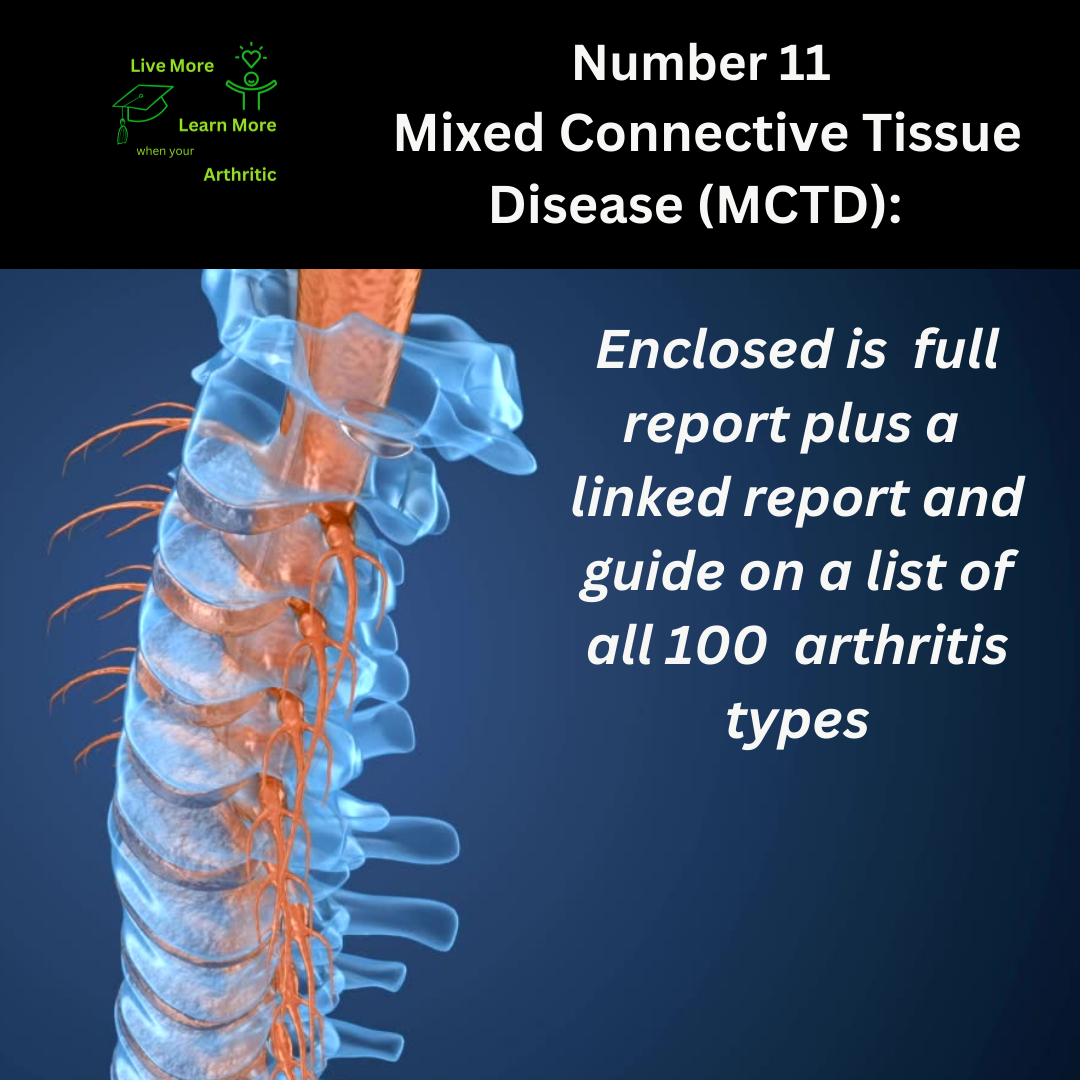
Mixed Connective Tissue Disease (MCTD): Number 11 on the list of 100 types of Arthritis
Embracing Life with Mixed Connective Tissue Disease (MCTD): Finding Hope Amidst Challenges
Imagine waking up one morning, feeling stiffness and pain in your joints, accompanied by overwhelming fatigue and difficulty breathing. This could be the reality for someone living with Mixed Connective Tissue Disease (MCTD), a rare autoimmune condition that affects the connective tissues in the body. While the journey may be daunting, many individuals with MCTD find strength and resilience in understanding and managing their condition with a proactive approach.
 Description of Mixed Connective Tissue Disease (MCTD)
Description of Mixed Connective Tissue Disease (MCTD)
Mixed Connective Tissue Disease is a complex autoimmune disorder characterized by overlapping features of several connective tissue diseases, including systemic lupus erythematosus (SLE), systemic sclerosis (scleroderma), and polymyositis. MCTD involves abnormal immune activity that targets various tissues and organs, leading to inflammation and tissue damage.
Causes and Triggers
The exact cause of MCTD is not fully understood, but it is believed to result from a combination of genetic predisposition and environmental triggers. Certain factors, such as viral infections or hormonal changes, may play a role in initiating the autoimmune response seen in MCTD.
Symptoms and Impact on Quality of Life
Symptoms of MCTD can vary widely and may include joint pain and stiffness, muscle weakness, skin changes (such as thickening or tightening), Raynaud’s phenomenon (changes in skin color and sensation in response to cold or stress), and organ involvement (such as lung or kidney problems). Limited range of motion in the joints can occur due to inflammation and tissue damage, affecting mobility and daily activities.
Age of Onset and Impact on Lifespan
MCTD can affect individuals of any age, but it most commonly develops in young to middle-aged adults, with peak onset occurring between the ages of 20 and 40. While MCTD is a chronic condition that requires ongoing management, it does not necessarily shorten one’s lifespan. However, the impact on quality of life can vary depending on the severity of symptoms and organ involvement.
Achieving a Higher Quality of Life
With a proactive approach, individuals with MCTD can enhance their quality of life and manage symptoms effectively. Strategies include:
- Regular Monitoring: Routine medical check-ups and monitoring of organ function are essential for early detection and management of complications.
- Medication Management: Working closely with healthcare providers to develop a personalized treatment plan involving immunosuppressive drugs, anti-inflammatory medications, or medications targeting specific symptoms.
- Lifestyle Modifications: Adopting a healthy diet, managing stress, getting regular exercise (as tolerated), and prioritizing adequate rest can help manage symptoms and improve overall well-being.
Possible Complications
Complications of MCTD can include:
- Organ Involvement: MCTD can affect various organs, including the lungs (interstitial lung disease), heart (pericarditis), kidneys (glomerulonephritis), and gastrointestinal tract (esophageal dysmotility).
- Increased Infection Risk: Immunosuppressive medications used to manage MCTD can increase susceptibility to infections.
 Holistic and Natural Approaches
Holistic and Natural Approaches
While there’s no cure for MCTD, some individuals find relief from symptoms through holistic approaches such as:
- Mind-Body Practices: Meditation, guided imagery, and relaxation techniques can help manage stress and promote emotional well-being.
- Dietary Modifications: Consuming anti-inflammatory foods, such as fruits, vegetables, and omega-3 fatty acids, may help reduce inflammation and support overall health.
- Alternative Therapies: Acupuncture, chiropractic care, and massage therapy may provide symptomatic relief for some individuals.
Prevalence and Gender Distribution
MCTD predominantly affects women, with a female-to-male ratio of about 3:1. While it can occur at any age, it most commonly develops in young to middle-aged adults.
In conclusion, living with Mixed Connective Tissue Disease requires resilience, adaptability, and a proactive approach to managing symptoms and improving quality of life. By embracing a multidisciplinary approach to care, including medical treatment, lifestyle modifications, and holistic strategies, individuals with MCTD can navigate their journey with hope and optimism. Each day becomes an opportunity to discover new ways of thriving despite the challenges posed by this complex autoimmune condition, fostering a sense of empowerment and strength in the face of adversity.